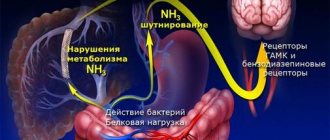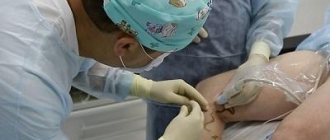Polyneuropathy, or peripheral neuropathy, occurs as a result of damage to the peripheral nerves and often results in symptoms such as weakness, numbness and pain, usually in the arms and legs. But polyneuropathy can also affect other areas of the body. Peripheral neuropathy may develop in one nerve (mononeuropathy), two or more nerves in different areas, or may involve many nerves (polyneuropathy).
The peripheral nervous system transmits information from the brain and spinal cord (central nervous system) to the rest of the body. Peripheral neuropathy can result from traumatic injuries, infections, metabolic disorders, hereditary causes, and exposure to toxins. One of the most common causes of polyneuropathy is diabetes mellitus.
Patients with peripheral neuropathy typically describe pain as a tingling or burning sensation. In many cases, symptoms decrease if compensation occurs for the underlying disease.
Each nerve in the peripheral nervous system has a specific function, so symptoms depend on the type of nerve that is damaged. Nerves are divided into:
- Sensory nerves that receive sensations from the skin, such as temperature, pain, vibration, or pressure
- Motor (motor) nerves that control muscle movement
- Autonomic nerves that control functions such as blood pressure, heart rate, digestion, and bladder function
Symptoms
Symptoms of polyneuropathy may include:
- Gradual onset of numbness and tingling in the legs or arms that may spread up the arms and legs
- Sharp stabbing or burning pain
- Increased sensitivity to touch
- Lack of coordination and falling
- Muscle weakness or paralysis if motor nerves are damaged
If autonomic nerves are involved, symptoms may include:
- Heat intolerance, as well as changes in sweating
- Digestive, bladder, or bowel problems
- Changes in blood pressure, which may cause dizziness
1.What is neuropathic pain?
Neuropathic pain, or neuropathic pain as it is also called, is complex chronic pain that is usually accompanied by tissue damage.
With neuropathic pain, the nerve fibers themselves can be damaged. Because of this, injured nerve fibers send incorrect signals to pain centers. In addition, due to injury, nerve function can be disrupted both in the area of injury and in surrounding areas.
One example of neuropathic pain is phantom syndrome, or phantom syndrome.
. This rare condition occurs when an arm or leg is amputated due to disease or injury, but the brain still receives signals of pain in the amputated part of the body and senses the limb and its apparent movement.
A must read! Help with treatment and hospitalization!
Causes
A number of factors can lead to the development of neuropathy, including:
- Alcoholism. A poor diet can lead to vitamin deficiencies.
- Autoimmune diseases. These include diseases such as Sjögren's syndrome, systemic lupus erythematosus, rheumatoid arthritis, Guillain-Barré syndrome, chronic inflammatory demyelinating polyneuropathy and necrotizing vasculitis.
- Diabetes. More than half of people with diabetes develop some type of neuropathy.
- Exposure to poisons. Toxic substances include heavy metals or chemicals.
- Medicines. Some medications, especially those used to treat cancer (chemotherapy), can cause peripheral neuropathy.
- Infections. These include some viral or bacterial infections, including Lyme disease, shingles, Epstein-Barr virus, hepatitis C, leprosy, diphtheria, and HIV.
- Hereditary diseases. For example, a disease such as Charcot-Marie disease is a hereditary type of neuropathy.
- Injury or compression on a nerve. Injuries such as car accidents, falls, or sports injuries can damage or even sever peripheral nerves. Nerve compression can occur when peripheral nerves are continuously impacted.
- Tumors. Malignant and benign tumors can damage or put pressure on nerves.
- Vitamin deficiency. B vitamins, including B-1, B-6 and B-12, vitamin E and niacin are important for nerves.
- Bone marrow diseases. These include the presence of an abnormal protein in the blood (monoclonal gammopathies), multiple myeloma, lymphoma and amyloidosis.
- Other diseases. These include kidney disease, liver disease, connective tissue disease and thyroid disease (hypothyroidism).
Complications of polyneuropathy may include
- Burns and skin injuries. If there is numbness in parts of the body, the patient may not feel temperature changes or pain.
- Infections. The legs and other areas of the body with reduced sensation may become unnoticed. It is necessary to monitor the integrity of the skin, especially if you have diabetes, since even minor damage to the skin can lead to tissue infection.
Assessment of neuropathic pain
Your healthcare provider will regularly ask you questions about your pain, such as:
- Rate your pain on a scale of 0 to 10. 0 is no pain and 10 is the worst pain you've ever experienced. If you are unable to assess your pain using numbers, you may be asked to describe it with words such as none, mild, moderate, severe, or intolerable.
For more information on how to describe pain, watch the video below.
to come back to the beginning
Diagnostics
When diagnosing polyneuropathy, a doctor may be primarily interested in answers to the following questions:
- Does the patient have any medical conditions such as diabetes or kidney disease?
- When did the symptoms begin?
- Were the symptoms constant or sporadic?
- How severe are the symptoms?
- What causes symptoms to increase or decrease?
- Did anyone in the patient's family have similar symptoms?
- The doctor needs a complete medical history. The doctor will review the patient's medical history, including symptoms, lifestyle, exposure to toxins, bad habits, and family history of neurological diseases.
- During a neurological examination, the doctor can check tendon reflexes, muscle strength and tone, the ability to feel certain sensations, and coordination.
The doctor may order an examination
- Imaging or MRI tests can detect various diseases (including tumors).
- Neurophysiology. Electromyography records electrical activity in muscles, which can help determine whether symptoms, including weakness, are caused by muscle tissue damage or nerve damage. ENMG checks the conduction of impulses along the nerves and allows you to determine the degree of damage to the nerve fibers. Neurophysiological studies of the autonomic nervous system may also be performed - sensory tests that record how the patient feels touch, vibration, cold and heat.
- Nerve biopsy. A doctor may recommend removing a small portion of a nerve, usually a sensory nerve, to examine morphological changes in the nerve to determine the cause of the nerve damage.
- Skin biopsy. In this test, a small portion of skin is removed to examine the number of nerve endings. A decrease in the number of nerve endings indicates neuropathy.
- Laboratory research methods are necessary to exclude various diseases, such as diabetes mellitus, autoimmune diseases, kidney disease, etc.
Neuropathic pain affects 7–8% of the general population. In the structure of cancer pain, it occupies 30%, with diabetes mellitus - 26%, herpes zoster - 19%, postoperative pain - 10% (according to 2021 data).
Sergei Gapanovich, head of the pain treatment room, anesthesiologist-resuscitator of the department of anesthesiology and resuscitation of Mogilev Hospital No. 1, chairman of the Belarusian Society for the Study of Pain. Clinical case: description
A 73-year-old woman presented with persistent pain and itching in the right chest area, just above the thoracolumbar junction, extending to the umbilicus (following a documented episode of herpes zoster in the same area a year earlier). The patient reported severe, continuous, burning pain, unpredictable paroxysms of stabbing pain lasting several seconds, and high hypersensitivity to mild tactile stimulation such as clothing touching the skin.
Physical examination revealed evidence of dermal scarring throughout the right T10 dermatome with areas of excoriation caused by persistent scratching. There is partial loss of tactile perception in this distribution, as well as areas of pain evoked by light touch. Paracetamol and standard NSAIDs do not help.
How would you handle the patient's condition?
Pathophysiology
Neuropathic pain (NP) is usually caused by a lesion or disease of the somatosensory nervous system - peripheral (83–94% of cases) or central (6–17%).
Damage to nerves leads to disruption of the mechanisms of generation and transmission of nociceptive signals in nerve fibers and the processes of control of the excitability of nociceptive neurons in the structures of the spinal cord and brain. Pathological mechanisms of peripheral and central sensitization develop. All this together underlies the NB phenomenon.
According to Russian researchers, 50% of those who consult a neurologist with pain are people with NB. NB affects 39% of cancer patients, 37–45% of those who have suffered a spinal injury, 20–25% of patients with diabetes mellitus, up to 85% after amputation, 10–66% after surgical interventions, 10–40% of patients with rheumatoid arthritis, spondyloarthritis.
Most common causes of peripheral neuropathy
- Diabetic peripheral polyneuropathy.
- Chemotherapy-induced polyneuropathy.
- Alcoholic polyneuropathy.
- Postherpetic polyneuropathy.
- Trigeminal neuralgia.
- Postoperative chronic NB.
- Phantom, post-traumatic NP, tunnel syndromes.
- Other variants of toxic, infectious (for example, HIV), hereditary, metabolic, drug-induced polyneuropathies.
Most common causes of central neuropathy
- Multiple sclerosis.
- Post-stroke pain.
- Traumatic spinal cord injury.
- Complex regional pain syndrome.
- Syringomyelia.
- Operated spine syndrome.
Combined pain syndromes (nociceptive, neuropathic, psychogenic components)
- Chronic back pain with radiculopathy.
- Oncological pain with tumor invasion of nerve trunks and plexuses.
The problem of NP is often accompanied by comorbid conditions: diabetes mellitus - 21% of cases, cardiovascular diseases - 32.4%, depression - 28.2%, cancer pathology - 5.6%, arthritis - 31.8%, fibromyalgia - 9.8 %, ankylosing spondylitis - 2%.
Diagnostics
To make a diagnosis of NB, a clinical examination is first necessary; instrumental methods are often of auxiliary value. The use of special questionnaires and scales for verification and quantitative assessment of NB should not replace clinical diagnosis. Auxiliary methods make it possible to determine the nature, location and severity of damage to the nervous system, but not to confirm or refute the presence of NB. These are methods such as electroneuromyography, the study of somatosensory evoked potentials, quantitative sensory testing, RCT, MRI.
Clinical diagnosis of NB includes:
- examination of the pain area and comparison with a healthy area (skin color and temperature, swelling, sweating),
- sensitivity study - tactile (cotton wool, paper napkin, monofilament), pain (blunt needle), temperature (thermal pen, test tubes), vibration (tuning fork),
- specific tests (Lasegue, Tinnel's symptoms),
- study of the motor system,
- assessment of muscle strength, reflexes, tone, hypotrophy.
International criteria for diagnosing NB include:
1. Localization of pain in the neuroanatomical zone.
2. History of involvement or disease of the peripheral or central somatosensory nervous system.
3. Identification of positive and negative sensory symptoms in the neuroanatomical zone.
4. Objective confirmation of damage to the somatosensory nervous system.
Qualitative characteristics of pain: like an electric shock, shooting, tingling, burning. The patient may complain of numbness in the affected area.
An important tool in diagnosing NB are rating scales that have high sensitivity and specificity. The most common are PainDetect (sensitivity 85%, specificity 80%), DN4 (83%, 90%), LANSS (82–91%, 80–94%), NRS/VAS.
The DN4 questionnaire consists of two blocks: the first is filled out based on a patient interview, the second - based on a clinical examination. The first block assesses positive sensory symptoms. The second is to identify allodynia and negative sensory symptoms. If the number of “yes” answers is >4, this means a high probability of having BN.
Diagnostic questionnaire for neuropathic pain DN4
Please mark one answer for each item in the questions below.
Read the continuation of the material here.
Treatment
The goal of treatment for polyneuropathy is to treat the underlying disease and minimize symptoms. If laboratory tests and other examinations indicate that there is no underlying disease, the doctor may recommend watchful waiting to see if the symptoms of neuropathy improve on their own. If there is exposure to toxins or alcohol, your doctor will recommend avoiding these substances.
Drug treatment
Medicines used to relieve pain from polyneuropathy include:
- Painkillers such as paracetamol or NSAIDs reduce pain
- Medicines containing opioids, such as tramadol (Conzip, Ultram ER and others) or oxycodone (Oxycontin, Roxicodone and others), can lead to dependence and addiction, so these drugs are generally prescribed only when other treatments have no effect.
- Anticonvulsants. Medications such as gabapentin (Gralise, Neurontin) and pregabalin (Lyrica), developed to treat epilepsy, can significantly reduce the pain of neuropathy. Side effects of these drugs may include drowsiness and dizziness.
- Capsaicin. A cream containing this substance (found naturally in hot peppers) can be used to provide some relief from the symptoms of neuropathy. But given the irritating effect of capsaicin on the skin, not all patients can tolerate the effects of capsaicin creams.
- Antidepressants. Some tricyclic antidepressants, such as amitriptyline, doxepin, and nortriptyline (Pamelor), can be used to reduce neuropathy pain through their actions on the central nervous system.
- The serotonin and norepinephrine reuptake inhibitor duloxetine (Cymbalta) and the antidepressant venlafaxine (Effexor XR) may also relieve pain from peripheral neuropathy caused by diabetes. Side effects may include dry mouth, nausea, drowsiness, dizziness, decreased appetite, and constipation.
- Intravenous immunoglobulin is the mainstay of treatment for chronic inflammatory demyelinating polyneuropathy and other inflammatory neuropathies.
- Alpha lipoic acid. Used to treat peripheral neuropathy in Europe for many years. This antioxidant helps reduce symptoms. You should discuss taking alpha lipoic acid with your doctor because it may affect your blood sugar levels. Other side effects may include stomach upset and skin rash.
- Herbs. Some herbs, such as evening primrose oils, may help reduce neuropathic pain in patients with diabetes.
- Amino acids. Amino acids such as acetyl-L-carnitine may help improve symptoms of peripheral neuropathy in patients undergoing chemotherapy and in patients with diabetes. Side effects may include nausea and vomiting.
In addition to drug treatment, other treatment methods may be used.
- Myostimulation allows, to a certain extent, to restore the conduction of nerve impulses through the muscles.
- Plasmapheresis and intravenous administration of immunoglobulin.
- Exercise therapy. If you have muscle weakness, physical activity can improve muscle strength and tone. Regular exercise, such as walking three times a week, can reduce neuropathy pain, improve muscle strength, and help control blood sugar levels. Exercises such as yoga and tai chi can also be quite effective.
- Acupuncture. Impact on biologically active points improves the sensitivity of nerve receptors and reduces pain.
Recommendations for patients with polyneuropathy
- It is necessary to take care of your feet, especially if you have diabetes. You should check your feet daily for blisters, cuts, or calluses. Soft, loose cotton socks and soft boots should be worn.
- You need to quit smoking. Smoking can affect circulation in the extremities, increasing the risk of foot problems and other neuropathy complications.
- Eat healthy. A healthy diet is especially important to ensure that the patient receives the necessary vitamins and minerals.
- We must avoid drinking alcohol. Alcohol can worsen the symptoms of polyneuropathy.
- Monitoring blood glucose levels in the presence of diabetes will help keep blood glucose levels under control and may help improve neuropathy.










